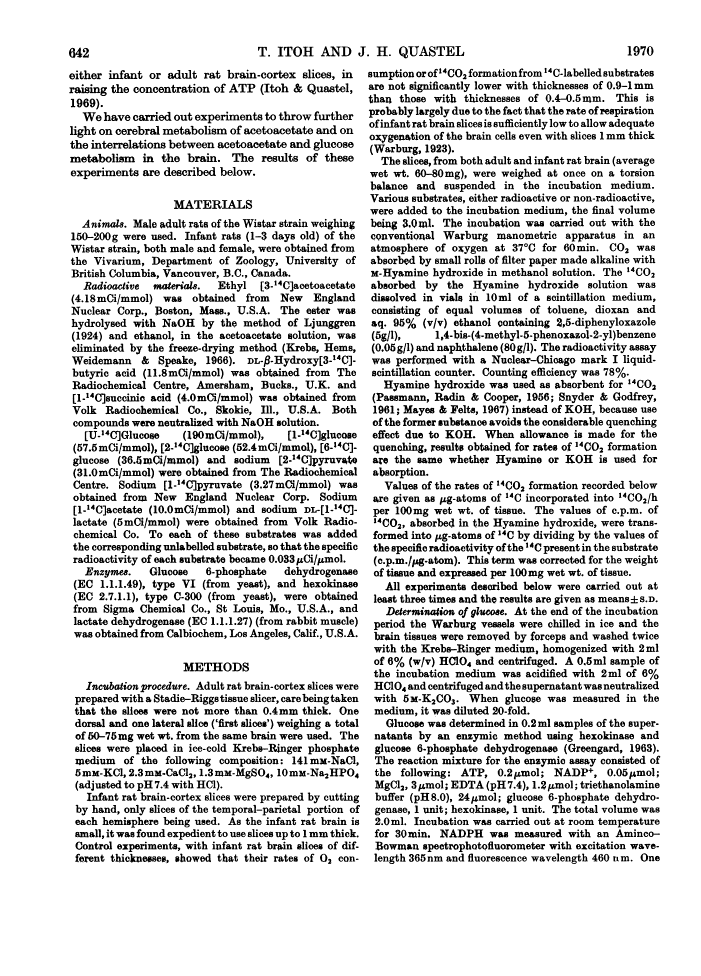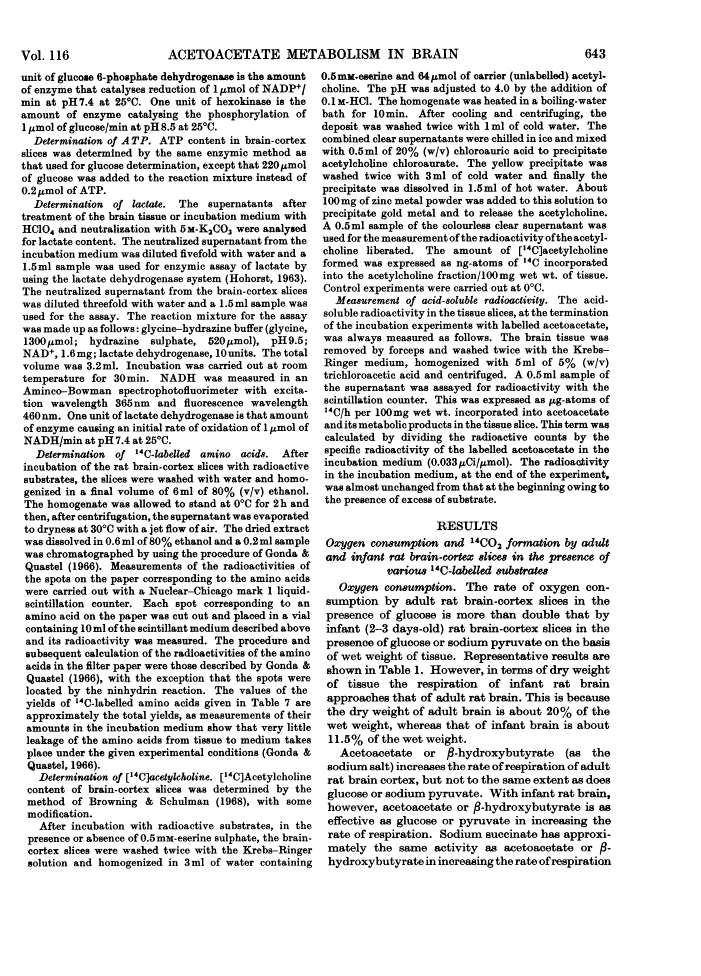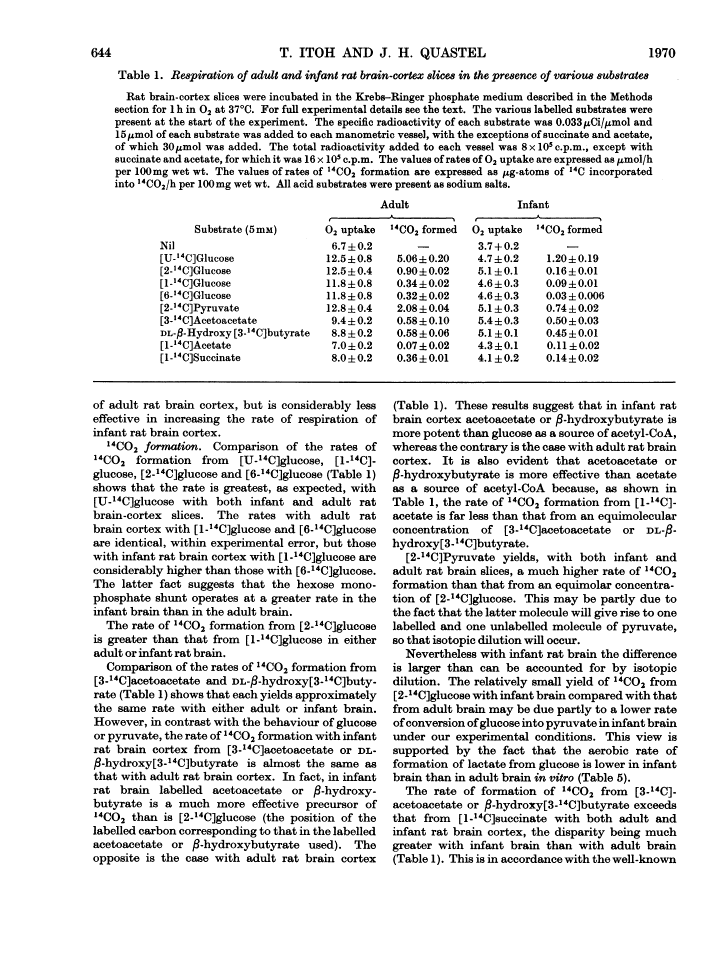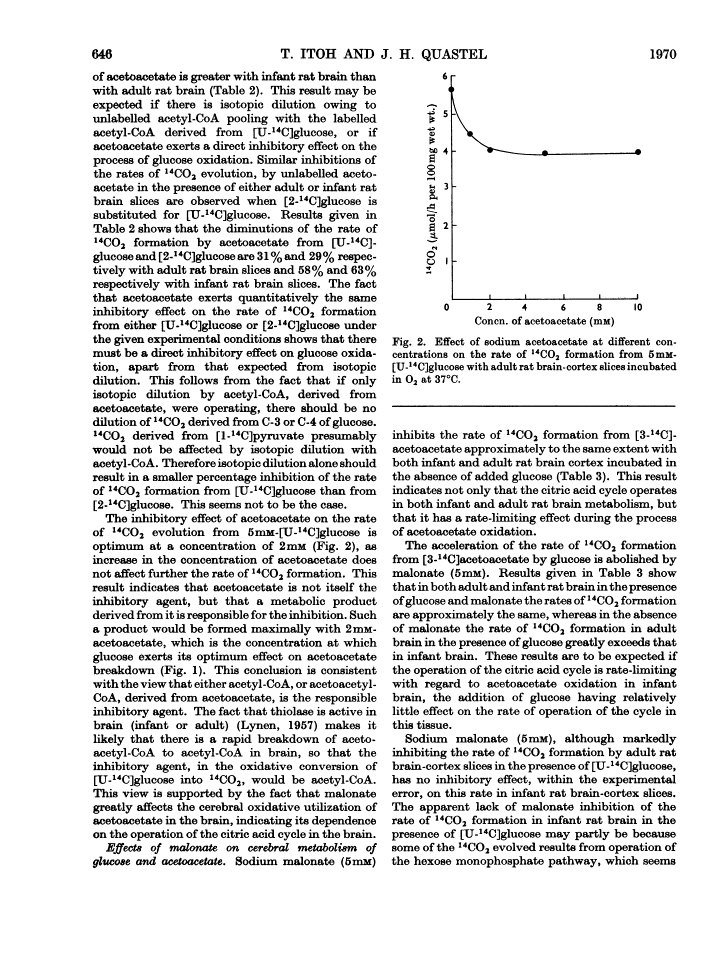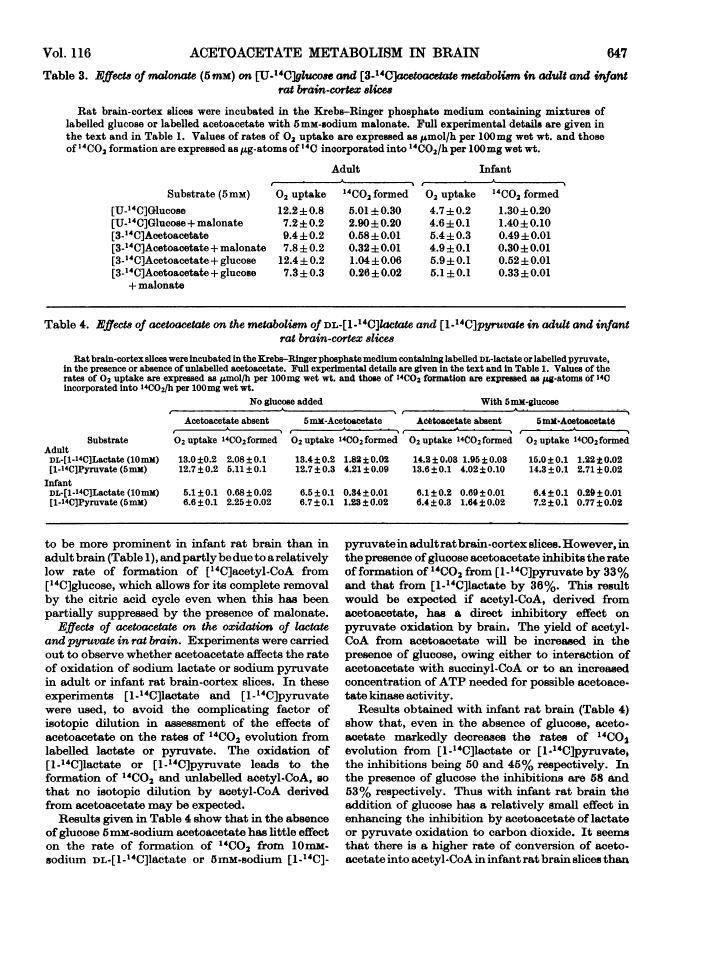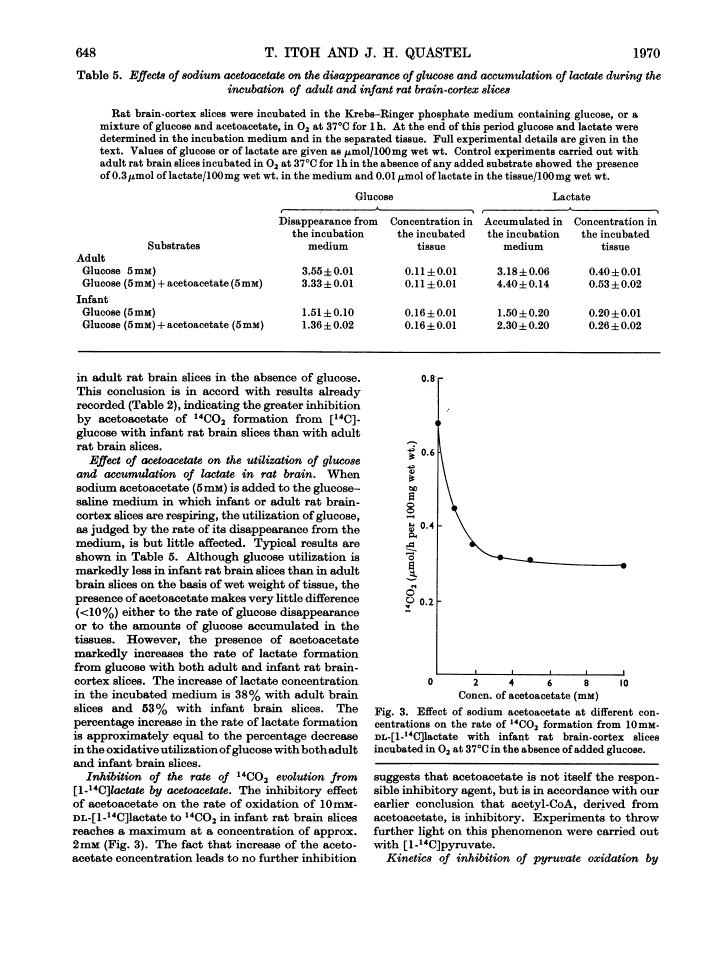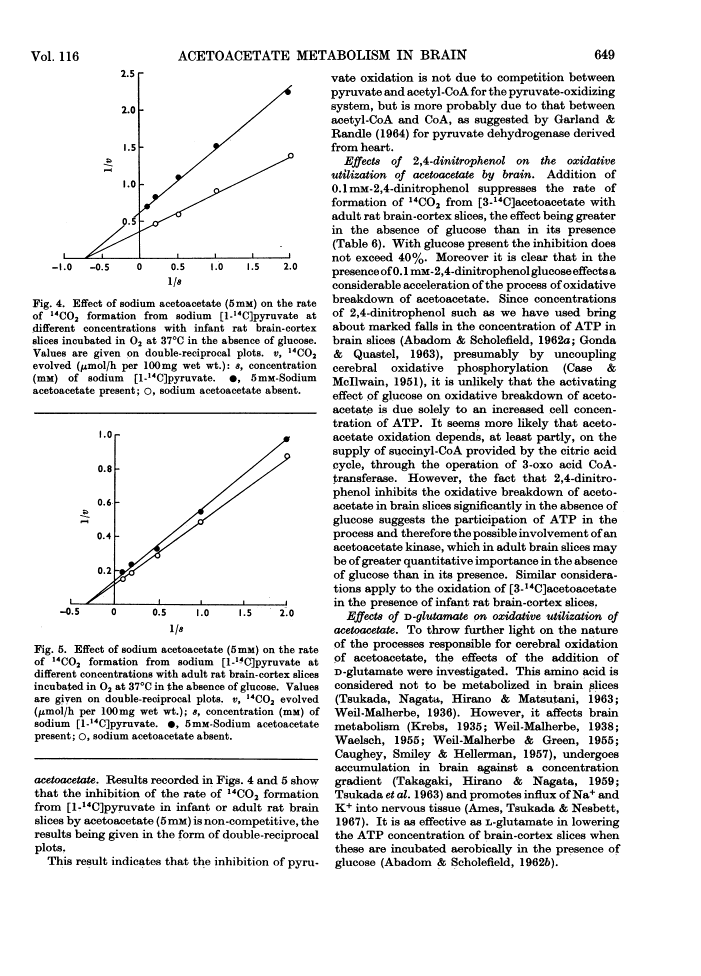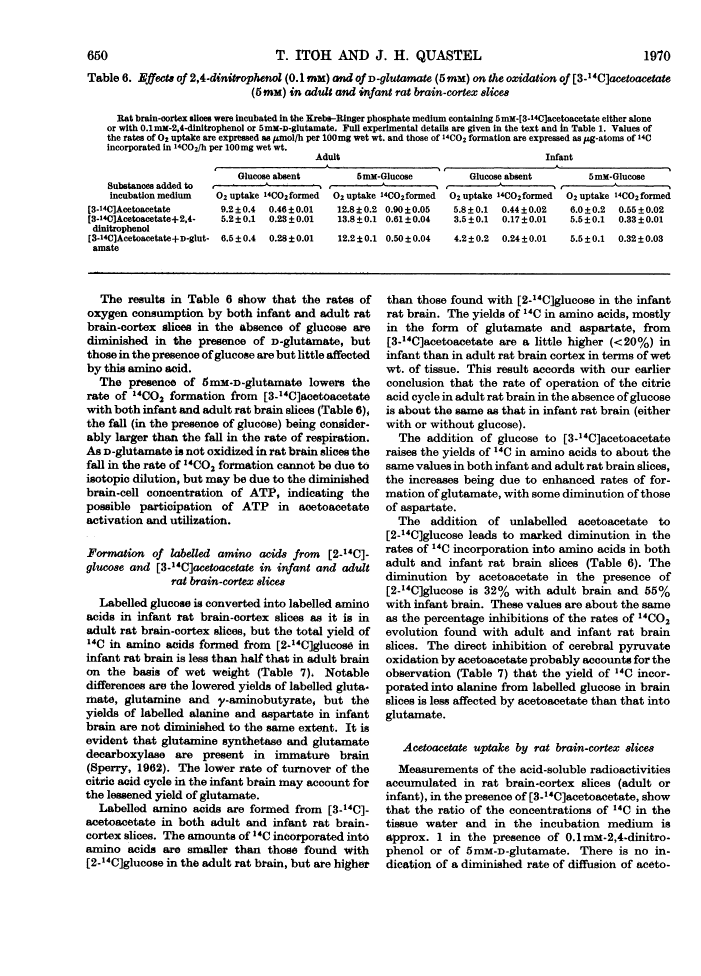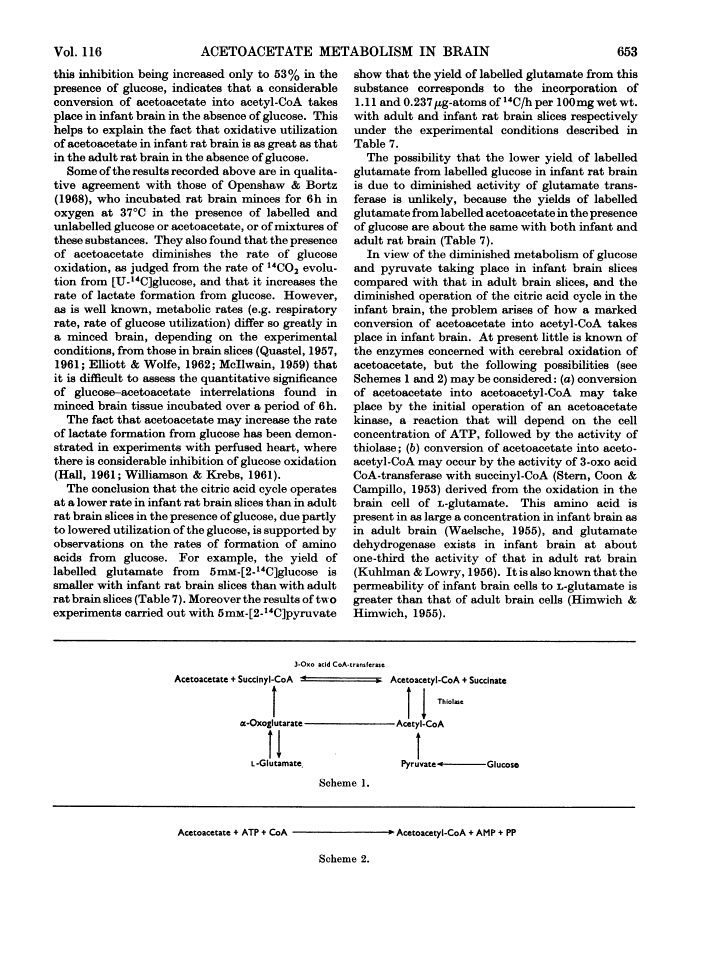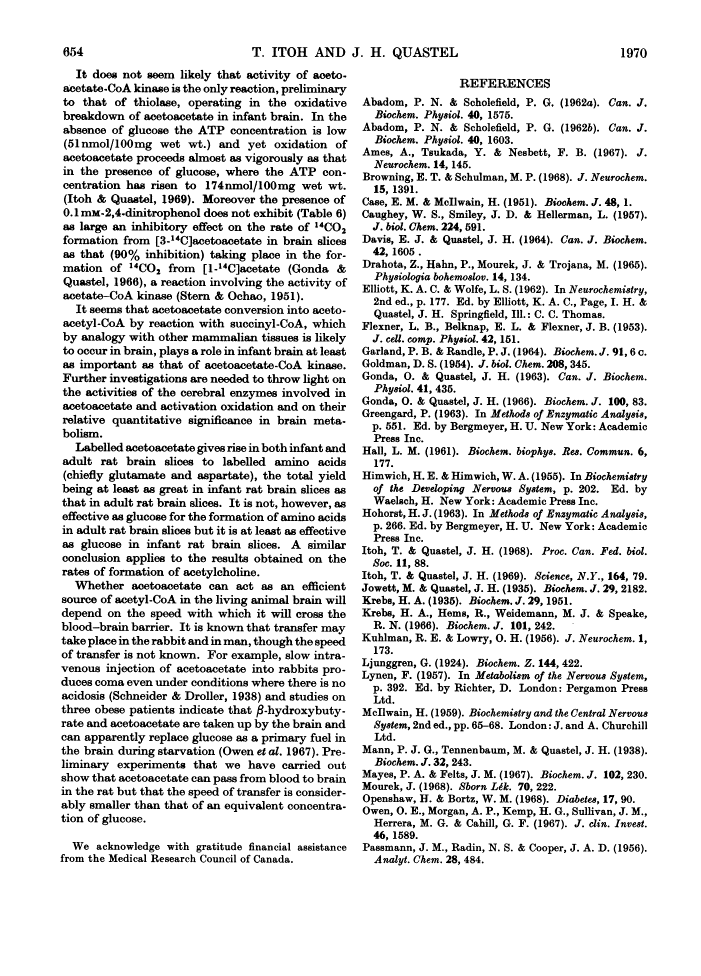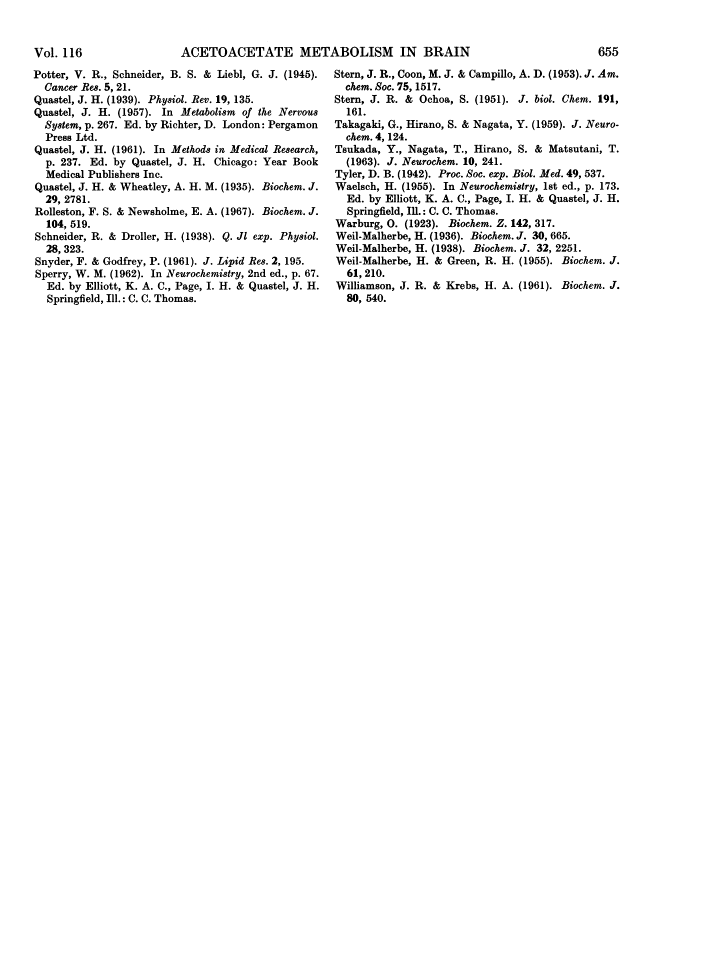Abstract
Free full text

Acetoacetate metabolism in infant and adult rat brain in vitro
Abstract
1. Acetoacetate or dl-β-hydroxybutyrate increases the rate of oxygen consumption to a smaller extent than that brought about by glucose or pyruvate in adult rat brain-cortex slices but to the same extent as that in infant rat brain-cortex slices. 2. The rate of 14CO2 evolution from [1-14C]glucose considerably exceeds that from [6-14C]glucose in respiring infant rat brain-cortex slices, in contrast with adult brain-cortex slices, suggesting that the hexose monophosphate shunt operates at a greater rate in the infant rat brain than in the adult rat brain. 3. The rate of 14CO2 evolution from [3-14C]acetoacetate or dl-β-hydroxy[3-14C]butyrate, in the absence of glucose, is the same in infant rat brain slices as in adult rat brain slices. It exceeds that from [2-14C]glucose in infant rat brain but is less than that from [2-14C]glucose in adult rat brain. 4. Acetoacetate is oxidized in the brain through the operation of the citric acid cycle, as shown by the accelerating effect of glucose on acetoacetate oxidation in adult brain slices, by the inhibitory effects of malonate in both infant and adult brain slices and by its conversion into glutamate and related amino acids in both tissues. 5. Acetoacetate does not affect glucose utilization in adult or infant brain slices. It inhibits the rate of 14CO2 formation from [2-14C]glucose or [U-14C]-glucose the effect not being wholly due to isotopic dilution. 6. Acetoacetate inhibits non-competitively the oxidation of [1-14C]pyruvate, the effect being attributed to competition between acetyl-CoA and CoA for the pyruvate-oxidation system. 7. Acetoacetate increases the rate of aerobic formation of lactate from glucose with both adult and infant rat brain slices. 8. The presence of 0.1mm-2,4-dinitrophenol diminishes but does not abolish the rate of 14CO2 formation from [3-14C]acetoacetate in rat brain slices. This points to the participation of ATP in the process of oxidation of acetoacetate in infant or adult rat brain. 9. The presence of 5mm-d-glutamate inhibits the rate of 14CO2 formation from [3-14C]acetoacetate, in the presence or absence of glucose. 10. Labelled amino acids are formed from [3-14C]acetoacetate in both adult and infant rat brain-cortex slices, but the amounts are smaller than those found with [2-14C]glucose in adult rat brain and greater than those found with [2-14C]glucose in infant rat brain. 11. Acetoacetate is not as effective as glucose as a precursor of acetylcholine in adult rat brain but is as effective as glucose in infant rat brain slices. 12. Acetoacetate or β-hydroxybutyrate is a more potent source of acetyl-CoA than is glucose in infant rat brain slices but is less so in adult rat brain slices.
Full text
Full text is available as a scanned copy of the original print version. Get a printable copy (PDF file) of the complete article (2.4M), or click on a page image below to browse page by page. Links to PubMed are also available for Selected References.
Selected References
These references are in PubMed. This may not be the complete list of references from this article.
- ABADOM PN, SCHOLEFIELD PG. Amino acid transport in brain cortex slices. I. The relation between energy production and the glucose-dependent transport of glycine. Can J Biochem Physiol. 1962 Nov;40:1575–1590. [Abstract] [Google Scholar]
- ABADOM PN, SCHOLEFIELD PG. Amino acid transport in brain cortex slices. III. The utilization of energy for transport. Can J Biochem Physiol. 1962 Nov;40:1603–1618. [Abstract] [Google Scholar]
- Ames A, 3rd, Tsukada Y, Nesbett FB. Intracellular Cl-, Na+, K+, Ca2+, Mg2+, and P in nervous tissue; response to glutamate and to changes in extracellular calcium. J Neurochem. 1967 Feb;14(2):145–159. [Abstract] [Google Scholar]
- Browning ET, Schulman MP. (14C) acetylcholine synthesis by cortex slices of rat brain. J Neurochem. 1968 Dec;15(12):1391–1405. [Abstract] [Google Scholar]
- CASE EM, McILWAIN H. Respiration and phosphorylation in preparations from Mammalian Brain. Biochem J. 1951 Jan;48(1):1–11. [Europe PMC free article] [Abstract] [Google Scholar]
- CAUGHEY WS, HELLERMAN L, SMILEY JD. L-glutamic acid dehydrogenase; structural requirements for substrate competition; effect of thyroxine. J Biol Chem. 1957 Jan;224(1):591–607. [Abstract] [Google Scholar]
- DAVIS EJ, QUASTEL JH. THE EFFECTS OF SHORT-CHAIN FATTY ACIDS AND STARVATION ON THE METABOLISM OF GLUCOSE AND LACTATE BY THE PERFUSED GUINEA PIG HEART. Can J Biochem. 1964 Nov;42:1605–1621. [Abstract] [Google Scholar]
- DRAHOTA Z, HAHN P, MOUREK J, TROJANOVA M. THE EFFECT OF ACETOACETATE ON OXYGEN CONSUMPTION OF BRAIN SLICES FROM INFANT AND ADULT RATS. Physiol Bohemoslov. 1965;14:134–136. [Abstract] [Google Scholar]
- FLEXNER LB, BELKNAP EL, Jr, FLEXNER JB. Biochemical and physiological differentiation during morphogenesis. XVI. Cytochrome oxidase, succinic dehydrogenase and succinoxidase in the developing cerebral cortex and liver of the fetal guinea pig. J Cell Physiol. 1953 Aug;42(1):151–161. [Abstract] [Google Scholar]
- GOLDMAN DS. Studies on the fatty acid oxidizing system of animal tissues. VII. The beta-ketoacyl coenzyme A cleavage enzyme. J Biol Chem. 1954 May;208(1):345–357. [Abstract] [Google Scholar]
- GONDA O, QUASTEL JH. Effects of acetylsalicylate and 2, 4-dinitrophenol on metabolism and transport in rat brain cortex in vitro. Can J Biochem Physiol. 1963 Feb;41:435–454. [Abstract] [Google Scholar]
- Gonda O, Quastel JH. Transport and metabolism of acetate in rat brain cortex in vitro. Biochem J. 1966 Jul;100(1):83–94. [Europe PMC free article] [Abstract] [Google Scholar]
- Krebs HA. Metabolism of amino-acids: The synthesis of glutamine from glutamic acid and ammonia, and the enzymic hydrolysis of glutamine in animal tissues. Biochem J. 1935 Aug;29(8):1951–1969. [Europe PMC free article] [Abstract] [Google Scholar]
- Krebs HA, Hems R, Weidemann MJ, Speake RN. The fate of isotopic carbon in kidney cortex synthesizing glucose from lactate. Biochem J. 1966 Oct;101(1):242–249. [Europe PMC free article] [Abstract] [Google Scholar]
- KUHLMAN RE, LOWRY OH. Quantitative histochemical changes during the development of the rat cerebral cortex. J Neurochem. 1956 Dec;1(2):173–180. [Abstract] [Google Scholar]
- Mann PJ, Tennenbaum M, Quastel JH. On the mechanism of acetylcholine formation in brain in vitro. Biochem J. 1938 Feb;32(2):243–261. [Europe PMC free article] [Abstract] [Google Scholar]
- Mayes PA, Felts JM. Determination of 14C-labelled ketone bodies by liquid-scintillation counting. Biochem J. 1967 Jan;102(1):230–235. [Europe PMC free article] [Abstract] [Google Scholar]
- Mourek J. Vztah kyseliny acetoctové a stárí k mnozství glyklogenu a k produkci kyseliny mléné v mozku krysy. Sb Lek. 1968 Jul;70(7):222–227. [Abstract] [Google Scholar]
- Openshaw H, Bortz WM. Oxidation of glucose, acetoacetate, and palmitate in brain mince of normal and ketotic rats. Diabetes. 1968 Feb;17(2):90–95. [Abstract] [Google Scholar]
- Owen OE, Morgan AP, Kemp HG, Sullivan JM, Herrera MG, Cahill GF., Jr Brain metabolism during fasting. J Clin Invest. 1967 Oct;46(10):1589–1595. [Europe PMC free article] [Abstract] [Google Scholar]
- Rolleston FS, Newsholme EA. Effects of fatty acids, ketone bodies, lactate and pyruvate on glucose utilization by guinea-pig cerebral cortex slices. Biochem J. 1967 Aug;104(2):519–523. [Europe PMC free article] [Abstract] [Google Scholar]
- STERN JR, OCHOA S. Enzymatic synthesis of citric acid. I. Synthesis with soluble enzymes. J Biol Chem. 1951 Jul;191(1):161–172. [Abstract] [Google Scholar]
- TAKAGAKI G, HIRANO S, NAGATA Y. Some observations on the effect of D-glutamate on the glucose metabolism and the accumulation of potassium ions in brain cortex slices. J Neurochem. 1959 Jun;4(2):124–134. [Abstract] [Google Scholar]
- TSUKADA Y, NAGATA Y, HIRANO S, MATSUTANI T. Active transport of amino acid into cerebral cortex slices. J Neurochem. 1963 Apr;10:241–256. [Abstract] [Google Scholar]
- Weil-Malherbe H. Studies on brain metabolism: The metabolism of glutamic acid in brain. Biochem J. 1936 Apr;30(4):665–676. [Europe PMC free article] [Abstract] [Google Scholar]
- WEIL-MALHERBE H, GREEN RH. Ammonia formation in brain. I. Studies on slices and suspensions. Biochem J. 1955 Oct;61(2):210–218. [Europe PMC free article] [Abstract] [Google Scholar]
- WILLIAMSON JR, KREBS HA. Acetoacetate as fuel of respiration in the perfused rat heart. Biochem J. 1961 Sep;80:540–547. [Europe PMC free article] [Abstract] [Google Scholar]
Associated Data
Articles from Biochemical Journal are provided here courtesy of The Biochemical Society
Full text links
Read article at publisher's site: https://doi.org/10.1042/bj1160641
Read article for free, from open access legal sources, via Unpaywall:
https://europepmc.org/articles/pmc1185409?pdf=render
Citations & impact
Impact metrics
Citations of article over time
Smart citations by scite.ai
Explore citation contexts and check if this article has been
supported or disputed.
https://scite.ai/reports/10.1042/bj1160641
Article citations
The Novel Role of Mitochondrial Citrate Synthase and Citrate in the Pathophysiology of Alzheimer's Disease.
J Alzheimers Dis, 94(s1):S453-S472, 01 Jan 2023
Cited by: 12 articles | PMID: 37393492 | PMCID: PMC10473122
Review Free full text in Europe PMC
Acute effect of glucose on cerebral blood flow, blood oxygenation, and oxidative metabolism.
Hum Brain Mapp, 36(2):707-716, 16 Oct 2014
Cited by: 19 articles | PMID: 25324201 | PMCID: PMC6869447
Ketogenic diet improves forelimb motor function after spinal cord injury in rodents.
PLoS One, 8(11):e78765, 04 Nov 2013
Cited by: 66 articles | PMID: 24223849 | PMCID: PMC3817084
Cortical substrate oxidation during hyperketonemia in the fasted anesthetized rat in vivo.
J Cereb Blood Flow Metab, 31(12):2313-2323, 06 Jul 2011
Cited by: 24 articles | PMID: 21731032 | PMCID: PMC3323194
PET study of 11C-acetoacetate kinetics in rat brain during dietary treatments affecting ketosis.
Am J Physiol Endocrinol Metab, 296(4):E796-801, 27 Jan 2009
Cited by: 37 articles | PMID: 19176356
Go to all (99) article citations
Data
Data behind the article
This data has been text mined from the article, or deposited into data resources.
BioStudies: supplemental material and supporting data
Similar Articles
To arrive at the top five similar articles we use a word-weighted algorithm to compare words from the Title and Abstract of each citation.
The fuel of respiration of rat kidney cortex.
Biochem J, 112(2):149-166, 01 Apr 1969
Cited by: 145 articles | PMID: 5805283 | PMCID: PMC1187688
THE EFFECTS OF ADENINE NUCLEOTIDES ON PYRUVATE METABOLISM IN RAT LIVER.
Biochem J, 95:587-596, 01 Jun 1965
Cited by: 9 articles | PMID: 14342491 | PMCID: PMC1206782
Lipogenesis from ketone bodies in rat brain. Evidence for conversion of acetoacetate into acetyl-coenzyme A in the cytosol.
Biochem J, 156(3):603-607, 01 Jun 1976
Cited by: 43 articles | PMID: 949342 | PMCID: PMC1163794
The biosynthesis of tetracycline.
Pure Appl Chem, 34(3):463-486, 01 Jan 1973
Cited by: 13 articles | PMID: 4266909
Review

